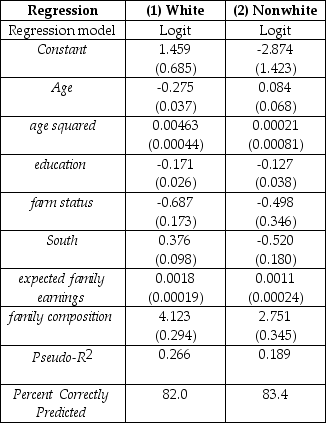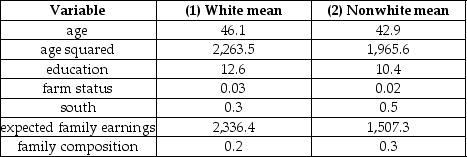A study tried to find the determinants of the increase in the number of households headed by a female.Using 1940 and 1960 historical census data,a logit model was estimated to predict whether a woman is the head of a household (living on her own)or whether she is living within another's household.The limited dependent variable takes on a value of one if the female lives on her own and is zero if she shares housing.The results for 1960 using 6,051 observations on prime-age whites and 1,294 on nonwhites were as shown in the table:
 where age is measured in years,education is years of schooling of the family head,farm status is a binary variable taking the value of one if the family head lived on a farm,south is a binary variable for living in a certain region of the country,expected family earnings was generated from a separate OLS regression to predict earnings from a set of regressors,and family composition refers to the number of family members under the age of 18 divided by the total number in the family.
where age is measured in years,education is years of schooling of the family head,farm status is a binary variable taking the value of one if the family head lived on a farm,south is a binary variable for living in a certain region of the country,expected family earnings was generated from a separate OLS regression to predict earnings from a set of regressors,and family composition refers to the number of family members under the age of 18 divided by the total number in the family.
The mean values for the variables were as shown in the table.
 (a)Interpret the results.Do the coefficients have the expected signs? Why do you think age was entered both in levels and in squares?
(a)Interpret the results.Do the coefficients have the expected signs? Why do you think age was entered both in levels and in squares?
(b)Calculate the difference in the predicted probability between whites and nonwhites at the sample mean values of the explanatory variables.Why do you think the study did not combine the observations and allowed for a nonwhite binary variable to enter?
(c)What would be the effect on the probability of a nonwhite woman living on her own,if education and family composition were changed from their current mean to the mean of whites,while all other variables were left unchanged at the nonwhite mean values?
Definitions:
Payback Period
The duration of time it takes to recover the cost of an investment, calculated as the point where net cash flow equals the initial investment.
Initial Cost
The initial expense associated with the purchase or investment in an asset before operational costs are considered.
Future Cash Inflows
Predicted incoming money to a company or project from operations, investments, or financing activities in the future.
Gelled Electrolyte
A semi-solid form of electrolyte used in batteries, typically to prevent leakage and improve performance and safety.
Q2: Explain why the two probabilities are identical
Q4: The logit model can be estimated and
Q9: Could mud wrestling be the cause of
Q11: Analyzing the effect of minimum wage changes
Q27: ARCH and GARCH models are estimated using
Q28: Consider two estimators: one which is biased
Q29: Under the VAR assumptions,the OLS estimators are<br>A)consistent
Q39: Canada and the United States had approximately
Q40: (Requires Appendix material and Calculus)The log of
Q47: In econometrics,we typically do not rely on